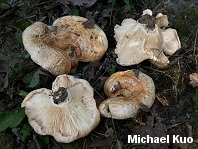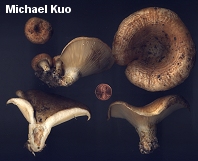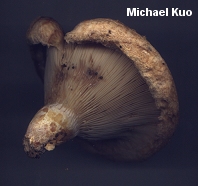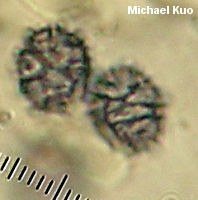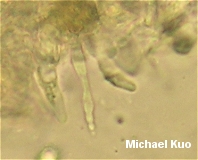| Major Groups > Gilled Mushrooms > Pale-Spored > Lactarius > Lactarius psammicola |

|
Lactarius psammicola [ Agaricomycetes > Russulales > Russulaceae > Lactarius . . . ] by Michael Kuo The mess surrounding the North American versions of the European species Lactarius zonarius gets my vote for All-Time Worst Lactarius Nightmare. We have, on our continent, a bunch of poorly understood and often poorly defined species, varieties, and forms that are similar to Lactarius zonarius. Among these, Lactarius psammicola is arguably the most clearly delineated and recognizable species. It is mycorrhizal with oaks in eastern North America and in Mexico, and can be distinguished by the following features:
Lactarius psammicola is often one of the more conspicuous and prolific summer mushrooms in eastern North America's oak-hickory forests. Description: Ecology: Mycorrhizal with oaks and possibly other hardwoods; growing alone, scattered, or gregariously; summer and fall; widely distributed east of the Rocky Mountains. Cap: 4-14 cm; at first with a deep central depression and an inrolled, hairy margin; later vase-shaped, with the margin typically remaining somewhat inrolled and softly leathery or finely hairy; slimy when fresh but soon dry; roughened; with buff and orange concentric zones of color. Gills: Running down the stem; close; rarely forking near the stem; whitish or buff, becoming darker and dirty; sometimes bruising brownish to lilac brown. Stem: 1-3 cm long; 1-2 cm thick; whitish, sometimes discoloring brownish where handled; tapering to base; with potholes. Flesh: Thick; white; unchanging when sliced. Milk: White; unchanging; not staining tissues, or staining them slowly brownish to lilac brownish; slowly staining white paper yellow. Odor and Taste: Odor not distinctive; taste strongly acrid. Chemical Reactions: KOH negative on cap surface. Spore Print: Yellowish to yellow. Microscopic Features: Spores: 7.5-9 x 6-7.5 µ; broadly ellipsoid; ornamentation about 0.5 µ high, as isolated, amyloid warts and short ridges that occasionally form partial reticula. Pleuromacrocystidia inconspicuous; to about 50 µ long; subfusiform to subcylindric. Cheilocystidia similar. Pileipellis a thick ixocutis. REFERENCES: Smith, 1941. (Hesler & Smith, 1979; Phillips, 1991/2005; Horn, Kay & Abel, 1993; Roody, 2003; McNeil, 2006.) Herb. Kuo 07089501, 08300202, 08300213, 09010201, 07070710. This site contains no information about the edibility or toxicity of mushrooms. |
© MushroomExpert.Com |
|
Cite this page as: Kuo, M. (2011, March). Lactarius psammicola. Retrieved from the MushroomExpert.Com Web site: http://www.mushroomexpert.com/lactarius_psammicola.html |
